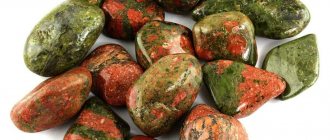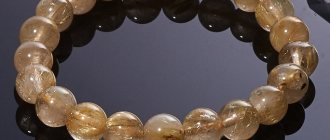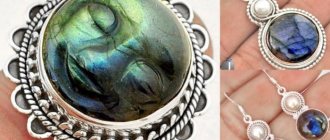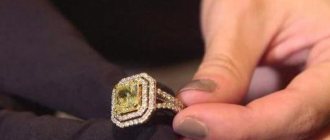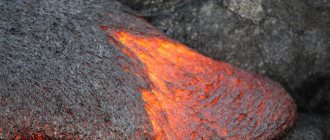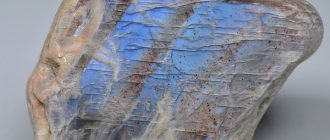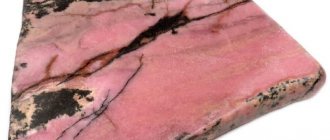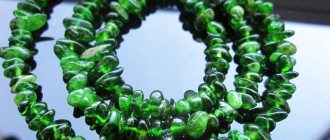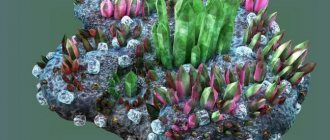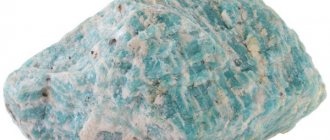| Category | Silicate minerals |
| Title in English | Diopside |
| Formula | CaMg[Si2O6] |
| Group | Pyroxene group |
| Color | Green, White, Colorless, Yellow, Black, Blue, Grey, Brown |
| Stroke color | White |
| Shine | Glass, Frosted |
| Transparency | Opaque, Transparent |
| singonia | Monoclinic |
| Hardness | 5,5 — 6,5 |
| Cleavage | Average |
| Density, g/cm³ | 3,25 — 3,55 |
| Kink | Rough, Conchoidal |
| origin of name | In order to name this mineral, two Greek words were used. This is δυ, which translates as two and ὄψις, meaning the word “guise”. If you add up the available data, you get “having two faces” or “two-faced”. The mineral received this name due to its main feature - birefringence of crystals. This is an optical distortion in which a direct beam of light can split into two within the gemstone. |
| Morphology | Diopside has naturally prismatic crystals with a nearly square cross-section. Crystals can be granular, lamellar, massive or columnar. |
The mineral diopside is one of the most unusual and unique gems. His name contains an indication of two “faces” of the stone, but in fact there are about five of them. Among the varieties of diopside, there are both transparent crystals with a blurred color, and black and dark gray glossy specimens that have the effect of a four-rayed star in their depth. Such a variety of diopsides are liked by jewelers and are widely used in the manufacture of jewelry for all occasions.
Diopside deposits
Diopside is widespread and found everywhere. Black stones are mined in the south of India, purple violans and emerald-colored chrome diopsides are mined in Altai, the Baikal region, Sayan Mountains, and the Sverdlovsk and Murmansk regions of Russia. Jewelry samples of yellow shades were found in the USA and Australia, yellow-green colors were found in Burma. Deposits in Italy are widely known, where pale blue and lilac diopsides were discovered. Crystals of red-brown and dark green shades are common in Canada and Sri Lanka, and emerald-colored ones are found in Pakistan.
Place of Birth
The stone occurs in basaltic rocks with a high content of olivine. In addition, gems are formed during the metamorphism of dolomites and limestones.
This mineral, distinguished by its rich color palette, is found in many parts of our planet. Large deposits are located in the following countries:
- Austria, where white stones with a cat's eye effect are mined;
- Italy - gems of green and purple tones were found in Piedmont, Trento and Valle D'Aosta;
- Sweden and Australia - yellow stones are mined there;
- USA - in the states of California and Illinois;
- Canada and South Africa;
- Brazil, Finland and Madagascar.
Deposits of the mineral have also been found in the Russian Federation.
Chrome diopside is mined in the Murmansk, Irkutsk and Chelyabinsk regions.
Deposits of blue gems have been discovered on the shores of Lake Baikal. This variety is called baikalit.
History of diopside
— Advertising —
Diopside differs from other minerals in its very wide color palette. Its name is translated from Greek as “double face,” which reflects this property, because natural diopsides are red, yellow, brown, green, purple, pink and black. In addition, the mineral has another name “malacolite”, which literally means “soft”, and refers to its low hardness and the location of the discovery of the first sample near the Ala River (Italy).
Origin story
Mineralogists consider diopside to be a rock-forming crystal. It is sometimes called malacolith (meaning soft). Previously it was called alalit. The stone received this name from the word Ala - a river in Italy, near which its first samples were found.
In Russia, the mineral was discovered in the Republic of Sakha. Its chemical and physical properties were studied by geologist A. M. Korchagin. He proved the value of the two-faced mineral.
However, before the official search for the crystal, there were also popular beliefs that were formed by ordinary people who accidentally stumbled upon diopside. They associated the unusual shape and iridescent green color with a serpent or dragon. It was believed that the stone contained the power of a sleeping multi-headed monster. If a drop of blood falls on the surface of the mineral, the spirit will awaken and endow the owner with special qualities. Thanks to the help of a mystical creature, you can improve your life and influence the future.
Physicochemical characteristics of diopside
The chemical composition of diopside is a mixed calcium-magnesium-silicon salt.
It contains impurities of various metals: iron, vanadium, chromium, manganese, zinc, aluminum, titanium, sodium, potassium. Without these inclusions, diopside remains colorless, and depending on their presence and quantity, it acquires its unusually wide range of colors. The hardness of mineral crystals on the Mohs scale is 5.5-6. Specific gravity 3.25-3.55 g/cm3. Refractive index 1.663-1.728. Birefringence 0.030. They have a monoclinic system and a glassy luster.
— Advertising —
The internal structure of opaque samples is wavy, which is associated with the appearance of pleochroism. Intensely colored transparent crystals do not have it.
physical characteristics
Has the following characteristics:
- weak glass luster, greasy tint;
- white line;
- uneven stepped fracture;
- density – from 3.27 to 3.38;
- hardness – from 5.5 to 6.
Formula: CaMg(Si2O6).
The composition also includes: iron, manganese, sodium, aluminum, titanium, vanadium, chromium, potassium. The gem practically does not decompose in acids.
Types of diopside
For diopside, according to its color characteristics, the following subspecies are distinguished:
- Black star is a black matte stone that has an asterism effect; when a directed beam of light hits it, a star with 4 rays appears on its surface.
- Chrome diopsides (“Siberian emeralds”) contain chromium oxides and are colored intense green.
- Laurel stones have an apple-green or grassy hue and contain a high percentage of vanadium.
- Salits are opaque yellow-green stones.
- Antochroites - have a delicate pink color due to the presence of manganese in their composition.
- Shefferites are red-brown diopsides containing large amounts of manganese.
- Jeffersonites are colored differently, from rich green to brown, or almost black.
- Violanes are violet or purple-violet diopsides containing compounds of iron and manganese.
In addition, diopside is classified depending on the structural features of the stone (cat's eye effect, asterism, pleochroism) and the presence of other minerals in its composition.
Products and decorations made of diopside
Set of jewelry with diopside
Diopside and products made from it cannot be called too expensive or cheap. The cost of a stone varies and depends on its type, processing method, place of extraction, rarity and quality.
Individual copies can be purchased at different prices, for example:
- “Black Star” in the form of a cabochon with an asterism effect – $7-10 per carat.
- Yellow stone with cat's eye effect - 5-6 dollars per carat.
- Chrome diopside, rich green color, step-cut - $10-25 per carat.
- A flat gray-blue violan weighing about 3 grams - for $7.
Diopside ring
The cost of jewelry with diopside also includes the price of the frame and the complexity of the product design:
- A silver ring with a black stone will cost $40-90 (depending on the size of the insert), and a designer maxi ring made of silver with three black cabochons will cost $188.
- Silver earrings with a “black star” cost $110-160, and designer earrings made of silver and gold in the shape of cats with chrome diapse cost $462.
- Chrome diopside chips strung on a thread (40 cm) - $11.
- Men's bracelet made of dark diopside with a cat's eye effect with a silver clasp - $52.
- A silver ring with a blue violin costs $30, and a set with earrings costs $63.
- Gold stud earrings with small chrome diopsides – $155.
The magical properties of diopside
Diopside is able to cleanse the aura of its owner from negative energy and fill the empty voids with positive energy.
For this purpose, the crystal without a frame is placed in the third eye area and left there for 5-10 minutes. At the same time, consciousness is cleared, thinking is activated and energy balance is restored. People endowed with extrasensory abilities use diopsides to understand magical signs that come to them from the outside. It is believed that with the support of this mineral, even an unenlightened person will be able to influence the consciousness of others, achieve sympathy and favor on their part. For this purpose, a ring with diopside is worn on the left hand.
The main thing is that diopside cannot be used for bad purposes. He does not like deception, and reveals dishonest actions, plans of swindlers and swindlers.
Talismans with diopsides are recommended for doctors, teachers, and representatives of the law.
Interesting facts about diopside
In large mineralogical museums you can find diopsides, the mass of which amounts to tens of carats. There are also specimens more than one meter long.
When exposed to ultraviolet light, you may notice a blue, yellow or brown glow. However, not all minerals have such luminescence. This property manifests itself only in those gems that are mined at great depths.
Diopside is an unusual mineral, because each crystal has its own color characteristics and chemical and physical properties. Despite all the research by mineralogists, many aspects remain unexplored. Perhaps diopside has yet to surprise humanity.
Medicinal properties of diopside
In lithotherapy, diopside is known as an effective stimulator of the cardiovascular system.
It prevents the development of angina pectoris, myocardial infarction, thrombophlebitis and atherosclerosis. The healing properties of the stone directly depend on its setting. For example, when diopside and silver are combined, it becomes a prophylactic against viral diseases and respiratory diseases (ARVI, influenza, bronchitis, tuberculosis, lung cancer). In this case, the stone is worn in the form of a ring or bracelet on the left hand. Diopside in a gold frame and on the right hand has a positive effect on the functioning of the digestive system.
In addition, diopside is considered a good helper in cases of nervous diseases, depression, fears and excessive aggressiveness. In such conditions, after contact with the mineral, a person becomes calm, confident, and his mood and morale improve significantly.
Areas of use
Diopside is considered a semi-precious and ornamental stone. It is often used among:
- Collectors. Unusual untreated specimens are often used to add to private collections. Options in which one color smoothly flows into another are especially appreciated. Also, collections often contain specimens of interesting shapes or crystals fused with other rocks.
- Designers. Souvenirs, memorable items or small details to complement the interior are made from processed crystals. Due to their softness, stones are easy to process, so among crafts made from natural crystals you can often see products made from malacolith.
- Jewelers The variety of colors, prevalence, softness and strength of the rock - all this makes diopside popular among creators of jewelry made from natural minerals. Jewelry turns out to be elegant and inexpensive, and thanks to its combination with other gems, it will be possible to create unique overflows and combinations.
Industries of application of diopside
Diopside is an ornamental stone.
Thanks to its natural softness and variety of colors, it is used to create various figurines, souvenirs, and items for interior decoration. In addition, diopside is used for magical amulets and ritual objects. Icons are embroidered with diopside beads. In jewelry, diopside is as popular as many gemstones due to its attractive appearance and relatively inexpensive price. The cut for it is step or diamond, cabochon or baguette, frames made of silver and gold, and such stones are used in the manufacture of earrings, rings, pendants, brooches, cufflinks and rings, bracelets, beads and necklaces.
In addition, diopside is a valuable collectible stone, specimens of which adorn collections around the world.
Application
The stone is soft and pliable. The mineral is used to make household items, figurines, trinkets and souvenirs. The use of natural specimens in decorating the interior space of premises is widespread.
Diopside is known for its magical properties and positive effects on human life. Natural samples from which talismans, amulets and amulets are made have such power.
Diopside beads are used in needlework for embroidering pictures and making miniature figurines.
The mineral is an excellent raw material for creating jewelry. Various techniques are used for cutting. Baguette or cabochon processing is common. In addition, diamond or step cutting is used. The stone is used to decorate rings, earrings, brooches, bracelets, and cufflinks. In this case, the specimens are set in gold or silver.
A stone with a rich color palette is valued by collectors all over the world. Natural specimens are exhibited in many famous museums. The Smithsonian Institution, for example, houses a star diopside weighing 133 carats.
Diopside and the zodiac sign
Astrologers do not single out favorites among the zodiac signs for Diopside. Amulets with it are suitable for everyone, only Capricorns and Aries should use this stone carefully. Representatives of these zodiac signs may be prone to scams, and diopsides absolutely cannot tolerate fraud and exchange. In such cases, they can even punish their owner, so diopside can only be used with pure intentions.
How to spot a fake
Stone scams are a thing of the past. However, even today there are cases when it is passed off as an emerald. To distinguish diopside, you should pay attention to strength and hardness. Emerald has much higher these qualities.
Real diopside cannot be perfect. It definitely has inclusions, small cracks and cutting errors. A perfect stone is a fake.
The gem will help its owner find a way out of the situation and will become an original decoration for everyday or evening wear. The main thing is to properly care for the mineral and not be passive, then the crystal will not stop helping its owner.
Mineral diopside: properties, description and formula
Diopside mineral photo Chemical formula of diopside: CaMg(Si2O6).
Calcium oxide makes up 25.9%, magnesium oxide - 18.5%, silicon oxide - 55.6%.
Also, the composition of this mineral is characterized by impurities of manganese, iron, chromium, vanadium and other elements.
The color of the stone depends on them. It comes in black, brown, blue, green, red, lemon.
Often there are diopsides that have a cat's eye color.
This mineral has the property of pleochroism: the shade of its color can change.
The crystals of the mineral have medium hardness and a characteristic glassy luster.
The stone itself is translucent to the point of transparency, but there are also opaque specimens.
Chemical properties and composition
Diopside is a mineral belonging to the pyroxene group. Close to hederbergite, but containing magnesium instead of iron. The chemical composition is a mixed silicate of calcium and magnesium. There is no clear boundary between diopside and hederbergite. The color of the stone depends on the content of iron and other impurities (V, Mn, Ti, Zn, Al). Containing only calcium and magnesium, the minerals are colorless and are the end member of the diopside-hedenberite series. Chrome diopsides have an emerald green color due to chromium impurities.
Chemical formula – CaMg [Si2O6].
Diopside: what kind of stone is it?
Diopside stone photo Diopside is classified as silicates from the pyroxene group.
Pyroxene is a rock-forming mineral that occurs in the form of prismatic crystals. Diopside is a stone that comes in a variety of colors.
The name diopside comes from the Greek words “dio” - two and “opsis” - vision.
The literal translation - double vision - reflects the property of diopside to change the shade of its color depending on the viewing angle.

